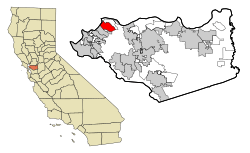Rodeo, California facts for kids
Quick facts for kids
Rodeo, California
|
|
|---|---|

Aerial view of Rodeo
|
|

Location in Contra Costa County and the state of California
|
|
| Country | |
| State | |
| County | Contra Costa |
| Area | |
| • Total | 4.632 sq mi (12.00 km2) |
| • Land | 3.747 sq mi (9.70 km2) |
| • Water | 0.885 sq mi (2.29 km2) 19.1% |
| Elevation | 16 ft (5 m) |
| Population
(2020)
|
|
| • Total | 9,653 |
| • Density | 2,084.0/sq mi (804.63/km2) |
| Time zone | UTC-8 (PST) |
| • Summer (DST) | UTC-7 (PDT) |
| ZIP codes |
94547, 94572
|
| Area code(s) | 510, 341 |
| FIPS code | 06-62490 |
| GNIS feature IDs | 1659538, 2409201 |
Rodeo (pronounced roh-DAY-oh) is a special type of community called a census-designated place (CDP). It's located in Contra Costa County, California, which is part of the San Francisco Bay Area. Rodeo sits on the eastern shore of San Pablo Bay, about 25 miles northeast of San Francisco.
In 2020, about 9,653 people lived in Rodeo. The town got its name from the "rodeo" events that were common in the late 1800s. Back then, cattle from the nearby hills were often herded through the town to a loading dock on the bay. From there, they were shipped to places where meat was processed. This practice continued into the early 1900s.
Rodeo is easy to reach by car using Interstate 80 and State Route 4. The first transcontinental railroad also passes through Rodeo, but trains haven't stopped there since the 1950s.
Contents
History of Rodeo
Rodeo's story began largely thanks to two brothers, John and Patrick Tormey. They bought land from the Ygnacio Martinez Rancho El Pinole estate in 1865 and 1867.
The Tormey brothers became very successful ranchers and business owners. They earned a lot of money and even held public jobs. Patrick Tormey, who has a nearby town named after him (Tormey), had a big dream. He wanted this part of Contra Costa County to become a major center for meatpacking and canning on the Pacific coast.
In 1890, Patrick Tormey teamed up with the Union Stockyard Co. He sold them some land and started making plans and investing a lot of money for stockyard buildings. Eventually, streets were built and land was prepared for homes. This is how the town of Rodeo was created.
Patrick Tormey also sold land in a nearby town called Oleum. This land was first used for a lumberyard, but later became an oil refinery for the Union Oil Co.. He also sold land in Selby, which was used by a company that processed metals. Patrick Tormey helped pay for the meatpacking plant, animal pens, and the Rodeo Hotel.
Rodeo's first post office opened in 1892.
After a difficult economic time in 1893, Patrick Tormey faced financial struggles as many businesses closed. The Union Stockyard Co. went bankrupt, and Patrick Tormey dealt with lawsuits about this for the rest of his life.
Even with these challenges, people in Rodeo found work in nearby towns. These included Crockett (home to C&H Sugar), Vallejo (where the Mare Island Naval Shipyard was), Hercules (known for Hercules Powder Co.), and the Union Oil Co. in Oleum.
Rodeo continued to be a community, but it was badly damaged by the 1906 San Francisco earthquake. After the earthquake, the town, like many others around the San Francisco Bay area, was rebuilt. There is a large oil refinery next to Rodeo that was built in 1896 and is now run by Phillips 66.
Geography
Rodeo covers a total area of about 4.6 square miles (11.9 square kilometers). Most of this area, about 81%, is land, and the remaining 19% is water.
Population Information
| Historical population | |||
|---|---|---|---|
| Census | Pop. | %± | |
| 1970 | 5,356 | — | |
| 1980 | 8,286 | 54.7% | |
| 1990 | 7,589 | −8.4% | |
| 2000 | 8,717 | 14.9% | |
| 2010 | 8,679 | −0.4% | |
| 2020 | 9,653 | 11.2% | |
| sources:; | |||
In 2010, Rodeo had a population of 8,679 people. The community is made up of people from many different backgrounds. About 44% of the population was White, 16.2% African American, 20.3% Asian, and 0.6% Native American. About 24.6% of the people identified as Hispanic or Latino.
Most people in Rodeo live in family homes. In 2010, there were 2,920 households. About 38.6% of these households had children under 18 living there. The average household had about 2.96 people.
The population is spread across different age groups. About 24.5% of the people were under 18 years old, and 12.2% were 65 years or older. The average age in Rodeo was 38.2 years.
Education
The Rodeo Library, which is part of the Contra Costa County Library system, is located in Rodeo. It provides books and resources for the community.
Notable People from Rodeo
Rodeo is the hometown of several well-known people:
- Billie Joe Armstrong and Mike Dirnt are members of the famous punk rock band Green Day. Billie Joe is the lead singer and guitarist, and Mike plays bass and sings backup.
- Lefty Gomez was a famous baseball pitcher for the New York Yankees. He played from 1930 to 1943 and is in the Baseball Hall of Fame.
- Eric the Actor was known for his appearances on The Howard Stern Show.
- Sabrina Rogers is a trumpet player for the Mariachi Divas de Cindy Shea and has won two Grammy Awards.
See also
 In Spanish: Rodeo (California) para niños
In Spanish: Rodeo (California) para niños

